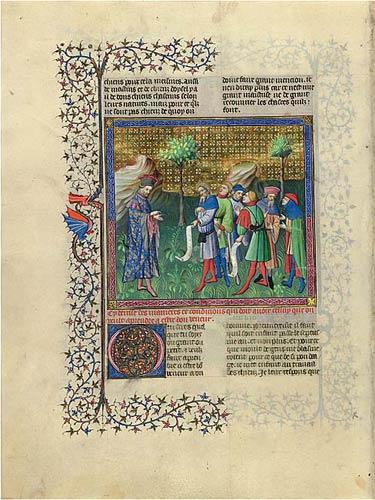
Livre de la chasse, in French and Latin
Illuminated possibly by the Josephus Master and the Bedford Master
Bequest of Clara S. Peck, 1983
Huntsmen, as young pages, were expected to know their hounds by name, appearance, and color. They are instructed in this miniature by an extremely fashionably dressed trainer. He wears a blue fur-lined, midcalf houpeland with gold embroidery and dagged bombard sleeves. Pink accents his collar and epaulettes as well as his matching chaussembles and the dagged sleeves of his pourpoint. His tall black bonnet is dramatically lined in red.
Luxury in a Time of Madness
In 1392 King Charles VI suffered the first of forty-four bouts of madness that would cripple his reign. During a lull in the Hundred Years' War, strife between France and Burgundy erupted into civil war. This domestic crisis was sparked by the 1407 assassination of Charles's brother by Duke John of Burgundy. In 1419 the duke, in turn, was murdered by supporters of the crown. During these tumultuous times, fashion reached unbelievable heights of luxury.
Men's and women's fashions were dominated by a new garment, the houpeland. Men's houpelands featured enormous sleeves and a skirt ranging from full length to crotch level. The pourpoint remained popular, albeit often finely embroidered and equipped with large sleeves. Accessories included fancy baldricks (sashes) and belts—both sometimes hung with bells. Tall bonnets or chaperons, often tied into imaginative shapes, completed the look.
Women's houpelands were always full length, with bombard or straight sleeves. The simpler cote hardy, with its voluminous skirt and tight upper body, continued to be worn. Women began to wear their hair in temples, a double-horned coif surmounted by veils or a tubular burlet.
